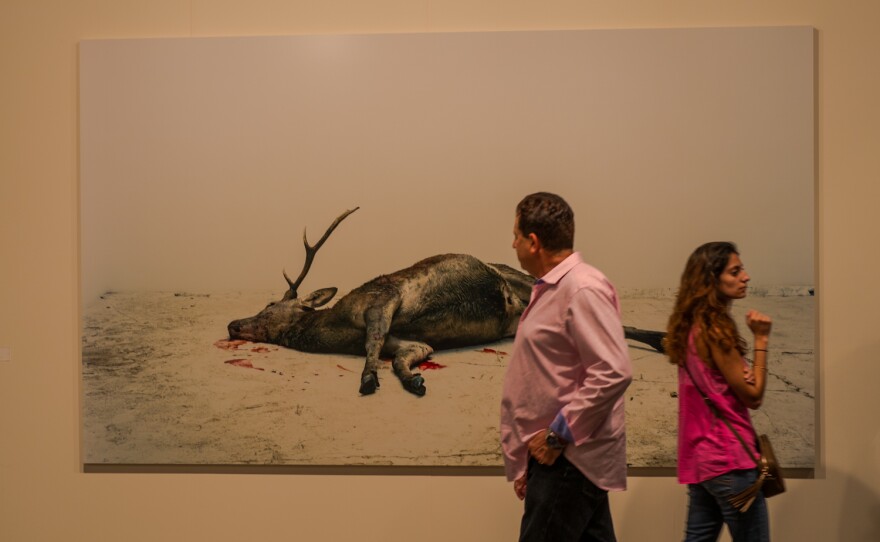Art Basel long ago grew beyond the Miami Beach Convention Center fair, and it has long been about more than just the art. Enough so that purists have complained about Miami's arts culture becoming an excuse for the kind of hyped-up parties that gave the area its shallow reputation.
But after witnessing, awestruck, the revelry in Wynwood this weekend, I can't help but wonder: Are the gallery hoppers and free-drink chasers who swarm streets during Art Week not part of the art experience?
At least a three-block radius from Northwest Second Avenue, between 20th and 29th streets, was crawling with Olsen-twin dress-alikes shouting in hard Miami accents, and middle-aged couples in jeans squeezed through hordes of slow-moving sartorial adventurers.
That’s not just a fashion show; it’s an exhibition on Miami’s appropriation of mainstream American culture. The way we absorb style trends displayed in the media by celebrities of every ethnicity but ours – because, face it, despite your background, “Miamian” trumps any other identity around here – even though they were not made to be worn while uttering endless “bros” and “dales,” is testament to Art Basel’s influence on us.
What is art? Is it this outfit?
While at first Basel on the beach and even Wynwood were somewhat exclusive settings, unknown to everyday “Miami people” – everyone you’d imagine Pitbull makes his music for – they have become such integral parts of Miami culture that partiers who frequented Space and Mekka two years ago now hit second-Saturday Art Walks and Basel satellite fairs for fun.
And so, Miami’s own mainstream culture shifts from the neons of South Beach to the murals of Wynwood and its surroundings. And the people become part of the art because Miami as a whole puts on a performance during Basel. We all come out.
Artist Michele Oka Doner told the Daily Beast: “[It’s] not the feeding frenzy that it was in the early years. I find it more refined. … Miami has learned how to behave at a world-class affair and still stay half-dressed.”
And isn’t that an art?
After Wynwood’s galleries closed, all that was left were parties. Northwest 24th Street, among others, boomed with the bass of various speakers blasting electronic dance music and the occasional throwback hip-hop beat. In one of the clubs, a group of about 30 took turns shuffling in the center of a circle.
I'm not particularly fond of that dance trend, nor the song that popularized it, but when enough people are shuffling, a room doesn't need a strobe light to look choppy. It's almost like watching something choreographed: Everyone participating knows when to break out, when to hoot in unison, and their movements are alike.
Also prevalent were poi dancers, one of them spinning fire in the video below. And another, maybe less artistic but equally fascinating, characteristic of Wynwood nightlife became evident through him: This is a community.
Standing on that street corner, surrounded by dozens of onlookers engulfed in the primeval pulse of hand-beaten percussion, I remembered drum circles and campfires and the hyperbolic, free-love ideals of some neo-hippie friends.
A couple kissed behind the fire dancer. The crowd cheered when he spun a complicated twist, and the drummers yelped when their beating wasn’t enough.
We were gathered across the street from Joey’s Italian Café, where valet attendants park wealthy people’s cars. We were feet away from a Miami-Dade Transit bus. We weren’t in a commune, or on a beach. We were in Wynwood!
But the performance, possibly spontaneous, was so entrancing it blurred the surroundings of its spectators. It drew them in. If I could say that much for most of the curated art I’ve seen in galleries I wouldn’t be such a fan of murals.
As I walked to my car near the I-95, this thought became clear: The crowds are an art show. Reality begins west of Northwest Fifth Avenue, or south of 23rd Street and north of 29th, where families still glare at the scandalous visitors.
Do you think the Art Basel crowds count as art? Tell us in the comments.
Then, read more about WLRN’s #WhatIsArt? project.


















